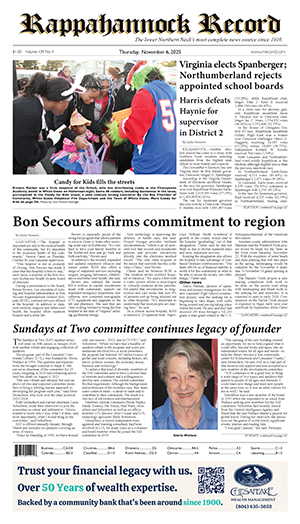Following up on last week’s item, after my friend and I left Yorktown, we drove along as much of the Colonial Parkway as we could, given the central part still being closed after many months of repairs, to Jamestown where English-speaking America was founded.
The best way to comprehend what Jamestown is, and was, is to take the free ferry across the James River over to Surry County, then to disembark and reboard for the return trip. The ferry affords the opportunity to see the settlement in the context of the island that became Virginia’s first capital. The scene from the ferry is substantially as it was in the time of Captain John Smith.
In 1957, in celebration of the 350th anniversary of the colonists’ landing on the island, the Commonwealth of Virginia supported the construction of a festival park with numerous exhibitions chronicling the course of Virginia’s history. At that time, Queen Elizabeth II and Prince Philip came to see the site while on a state visit to Washington to see President Eisenhower.
They returned in 2007 for the 400th anniversary, the exhibits for which were more archaeological in scope, with the benefit of 50 years of digging to bring to light the fabric of colonial life in the 17th century.
Jamestown is of particular importance to those of us in the Northern Neck, for on October 12, 1648, the Grand Assembly, the antecedent of the modern Virginia General Assembly, meeting at Jamestown, enacted legislation establishing all of the land between the Potomac and the Rappahannock Rivers, from the Chesapeake Bay to a line drawn between the headwaters of the two rivers, as Northumberland County, Virginia.
The Assembly’s motivation came from Lord Baltimore’s plan not to allow settlement on Kent Island, the largest island in the Chesapeake Bay, thereby causing residents there to emigrate and move to the southern shores of the Potomac River. The Virginia Assembly feared that Lord Baltimore might claim the Northern Neck as part of Maryland, and to avert that scenario from happening, the Assembly acted.
Appropriately, Northumberland County was named for Northumbria in England, the northernmost of the English counties, but the original size of Virginia’s Northumberland did not last for long, with Lancaster splitting off in 1652 and Westmoreland in 1653, thereby leaving the present Northumberland County in its present configuration.
Jamestown remained the capital of the Virginia Colony until 1699 when the seat of government was moved to Williamsburg, a better location given its inland position that provided for greater safety. From that point on, Jamestown went into a period of decline, and the “first permanent English-speaking settlement in the New World” ceased to be occupied and largely reverted to nature, until its rediscovery archeologically in the late 19th century in preparation for the 300th anniversary in 1907.
Ironically, that celebration was held in Norfolk, given the lack of accommodations and facilities near Jamestown. The 1907 festivities were not financially successful, probably because of lack of convenient access to Jamestown. Mary Costello Cahill, who was in effect the foundress of tourism in the Northern Neck, went down to Norfolk and leased a large hotel expecting crowds of history buffs eager to participate in the celebrations. Unfortunately for her, the hordes never came. She returned to the Northern Neck, and thereafter stuck to reliable American-plan hotels at Colonial Beach where she knew the steamboats would bring the tourists en masse.
Unlike tourists from previous periods, today’s visitors to Jamestown can benefit from the archeological research that has brought the history of the settlement into its proper light as the stepping off point for modern America.






